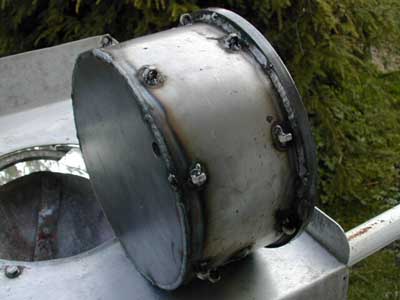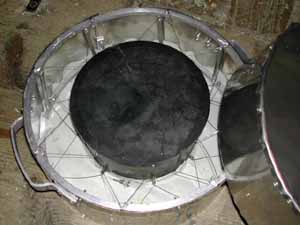
Paper presented at the 'Encuentro Solar 2003' in Benicarlo, Spain in June 2003
Dr. Michael Götz, ULOG Suisse, Rue Matile 71, CH-2000 Neuchâtel,
Switzerland,
info@cuisinesolaire.com,
http://www.cuisinesolaire.com/
Two heat storage elements for Scheffler parabolic solar cookers have been
fabricated and tested. The first one consists of solid aluminium, it stores
the sensible heat. The second is filled with tin and also uses the latent
heat of the solid-liquid phase change.
The advantages of the phase-change element is the higher useful part of the
stored energy (72% as compared to 58% for the solid element) and the fact,
that it quickly reaches its working temperature. The stored energy of 1 kWh
is enough to cook for a family in the evening.
1. Theory
Our goal is to store for evening cooking the heat produced during the day
on a Scheffler parabolic cooker. This can be done by heating up a metal block
and using it later on as a cooking plate (using the so-called sensible heat
of the metal). Another way is to melt a material with the heat from the parabolic
cooker. The energy which the material produces when it becomes solid again
is then used for cooking. Energy stored in a phase-change is called 'latent
energy'.
For our study, two storage elements have been compared: The first one consists of 25kg of aluminium, the second one is a steel bin filled with 28kg of tin. While the aluminium stays solid, the tin melts at 220°C and stores ½ kWh of energy in the phase change. Total energy above 180°C stored is a little more than 1 kWh for each element.
 |
The comparison shows that the element containing tin stores a high proportion of its energy in the interesting range of 180°C to 300°C. The energy below 180°C cannot be used for baking pancakes and the energy above 300°C is leading to high heat losses. |
2. Manufacturing
Both elements were fabricated in the workshop of Solare Brücke with
the help of Wolfgang Scheffler and Heike Hoedt. For the tin storage element,
a steel recipient was prepared and filled with tin rods directly in the focus
of a 8m2 Scheffler parabolic cooker. It was hermetically closed at 400°C.
Both the tin and the aluminium elements were insulated using a high-tech
material with a very low thermal coefficient. An outer shell of stainless
steel and removable insulated top and bottom covers have been added to both
elements.
 |
 |
| The steel recipient which (later) contains the tin. | The tin filled steel recipient is hung in a stainless steel containment which is ready to be filled with the insulation. |
3. Cooking
The storage element is heated from below and cooking is done on top of it,
either while it is being heated or later in the evening. On very sunny days,
400°C have easily been reached and the shutter of the cooker was closed
to protect the thermometers which were rated up to 400°C.
 |
 |
| Top view of potatoes and egg being prepared on the storage element. | Espresso is brewed on the storage element. |
4. Selling pancakes from the storage units
The units have been used a few times to bake pancakes while the temperatures
inside and on top of the storage elements were measured for later analysis.
The following graphic shows such measurements on a day with a mixture of
sunshine and clouds. The advantage of the tin of reaching quickly the minimum
working temperature (while the tin is still solid) is critical on such a
day. The aluminium block on the other hand could only be used for baking
pancakes at the end of the afternoon. Note that the temperature on top of
the element is reduced by a few degrees centigrade each time a pancake is
produced - you can count the pancakes on the graph !

Shown above are the temperatures of both elements on a day with mediocre
sunshine. For each element, three readings are shown (top, inside and bottom).
Each time a pancake is produced, the temperature drops for a few minutes.
5. Conclusions
· Both elements have been successfully used for cooking and baking
pancakes.
· The mobile use of the elements is difficult due to the high mass.
· The advantage of the tin block is that it reaches quickly its working
temperature and that it stores more energy in the most useful range between
180°C and 300°C.
· Using a metal instead of a salt for the latent heat storage has advantages
like improved safety and easy recycling.
· The elements should be directly integrated in the rack of the Scheffler
cookers and they should be even better insulated.
The author would like to thank the Swiss energy department for the funding of the project and Heike and Wolfgang for their help.
Interested: